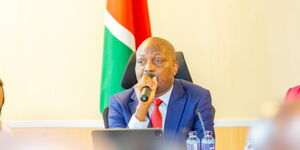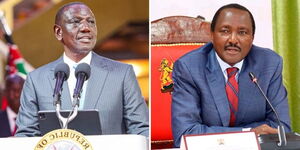Global credit rating agency Moody’s has sent a warning to Kenya over its capacity to pay its high levels of debt, faulting domestic borrowing as a strategy to service the trillions owed by Kenya.
In its latest outlook on Kenya released on Wednesday, July 23, Moody’s revealed that the cost of servicing debts is expected to remain high, as the government pins its hopes on the local market to fund its budget shortfalls.
As per Moody’s, continued reliance on domestic borrowing might have a huge impact on Kenya’s credit sustainability and credit profile.
"Kenya will rely predominantly on the domestic market to meet its fiscal financing needs with approximately two-thirds of its financing, or just under four per cent of GDP per year, from domestic sources," the agency said in an issuer report.
"This reliance will continue to weigh on debt affordability, a key constraint in Kenya's credit profile."
The agency highlighted the weak structures in the nation’s revenue generation, with the ratio of tax to gross domestic product standing at about 17 per cent.
Moody’s also cautioned against the unreliable expenditure structure, as the government spends a third of its revenue on settling interest payments. Add the high wage bill, allocations to counties, and pensions, and this results in more than half the budget going to recurrent expenditure. This would then limit the capacity to carry out spending cuts, putting the country in a precarious economic position.
In the new budget passed last month, Treasury Cabinet Secretary John Mbadi indicated that the government aimed to borrow a total of Ksh923.2 billion, with Ksh287.7 billion from external sources and a whopping Ksh635.5 billion from the domestic market.
The Ksh4.2 trillion budget, the largest in Kenya's history, the National Treasury has projected revenue collection of Ksh3.322 trillion for the fiscal year 2025/26, including ordinary revenue, appropriations-in-aid, and grants.
Currently, Kenya has a public debt of Ksh11 trillion. Of this, Ksh5 trillion comprises domestic debt, while Ksh5.09 trillion accounts for external debt. Domestic debt largely consists of Treasury Bills and Bonds, whereas external debt is owed to multilateral, bilateral, and commercial creditors.
At the moment, Kenya’s debt level stands at 63 per cent of its GDP well above the stipulated 55 per cent.
Even as CS Mbadi has previously maintained that the country is on track to pay its massive debt, Moody’s noted several underlying factors that may be a stumbling block in the state’s quest to pay off debts.
For instance, the agency disclosed that Treasury yields had nearly halved in the past year, with Kenya’s interest-to-revenue ratio currently at an elevated 33 per cent, putting Kenya sixth globally.
The interest-to-revenue ratio is a crucial financial metric for governments (sovereigns). It calculates the percentage of a government's total revenue (primarily from taxes and other non-debt sources) that is used just to pay the interest on its existing public debt. It does not include the repayment of the principal amount of the debt, only the interest charges.
At 33 per cent, this means that for every 100 shillings Kenya collects in revenue, approximately 33 shillings (or one-third) are immediately allocated to cover the interest payments on its national debt.
This means Kenya is spending a very large portion of its income just to keep up with the interest payments on its loans. This leaves less money available for essential public services, development projects, infrastructure, healthcare, education, or other government expenditures.
To avert this, Moody’s suggested the government needs to secure a new financing programme with the International Monetary Fund, to help it deal with annual external debt repayments that stand at $3.5 billion (Ksh450 billion) on average.
The government is set to hold another round of talks in September with IMF officials as it aim to secure the funding.












